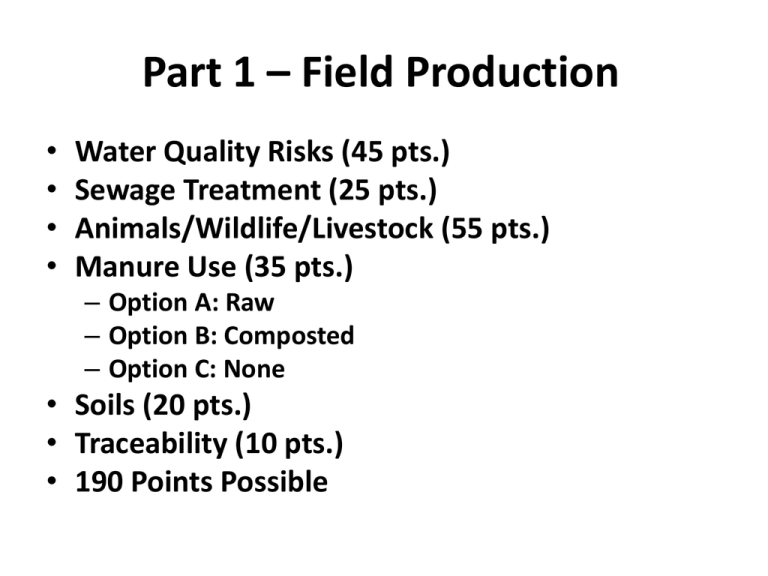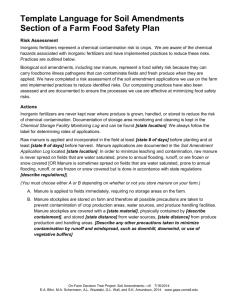Part 1 – Field Production
advertisement

Part 1 – Field Production • • • • Water Quality Risks (45 pts.) Sewage Treatment (25 pts.) Animals/Wildlife/Livestock (55 pts.) Manure Use (35 pts.) – Option A: Raw – Option B: Composted – Option C: None • Soils (20 pts.) • Traceability (10 pts.) • 190 Points Possible Field Production: Water Management • Water quality must be evaluated to reduce microbial risks in fresh produce. • Currently there are no federal standards for irrigation water quality • In the absence of a federal standard, the adoption of the EPA recreation water quality standard is common in most states, including Arizona • If water can be used to swim in, it can be used for irrigation 1-1 What is the source of irrigation water? (Pond, Stream, Well, Municipal, Other). 1-2 How are crops irrigated? (Flood, Drip, Sprinkler, Other). 1-3 Water Quality Risks • A water quality assessment must be performed to determine the quality of water used for irrigation purposes • E. coli 0157:H7, Salmonella, Giardia, and Cyclospora outbreaks have been caused by contaminated water • However, for GHP/GAP, generic E. coli is used as an overall indicator of water quality 15 Points Document: Irrigation Water Log Enteric Bacteria Bacteria of the Intestines Shigella (Dysentery) COLIFORM BACTERIA Soil, Vegetation, Feces Salmonella (Illnesses) Enterobacter Fecal Coliforms: Greater Risk (Infections) E. coli Pathogenic E. coli 1-3 Water Quality and Testing • • • • Test for generic E. coli and request that the results be quantified. Do NOT request an absence-or-presence test. If only one sample is taken, it must be below 126 CFU/100 mL. A specific commodity, buyer or location might require additional testing. Water source Testing frequency Municipal water in US At least 1x/year Well water At least 1x/year during production Surface water At least 3x/year * Before use * At peak use * Close to harvest 15 Points Document: Irrigation Water Log 1-4 Water Quality Risks Water used for chemical application or fertigation must be potable. 15 Points Document: Water Source Testing Log Compost Teas Background Bacteria in Compost Teas 9 8 7 Log10 CFU/Kg 6 E.coli 5 Salmonella/Shigella 4 Enterococcus 3 Pseudomonas 2 Lactic acid 1 0 Horse Cow/Plant products Cow Plants products Alpaca Sheep Background Bacteria in Compost Teas 9 8 7 Log10 CFU/Kg 6 5 E.coli 4 Salmonella/Shigella 3 Enterococcus 2 Pseudomonas 1 Lactic acid 0 Horse Cow/Plant products Cow Plants products Alpaca Sheep 1-5 Water Quality Risks Continued…. Steps must be taken to protect irrigation water from potential direct and nonpoint source contamination 15 Points 1-6 Sewage Treatment It is imperative to have a farm sewage treatment systems that function properly where there is no evidence of leaking or runoff. 15 Points 1-7 Sewage Treatment There is NO municipal/commercial sewage treatment facility or waste material landfill adjacent to the farm 10 Points 1-8 Animals/Wildlife/Livestock Crop production areas are not located near or adjacent to dairy, livestock, or fowl production facilities unless adequate natural or physical barriers exist. • Concentrated Feed Lot Operation, Manure Composting: 400 feet • Grazing Lands and Homes with Septic Systems: 30 feet • Untreated Manure & Irrigation Water: 200 feet 15 Points 1-9 Animals/Wildlife/Livestock Manure located near or adjacent to crop production areas are maintained to prevent leaking or overflowing, or measures have been taken to stop runoff from contaminating the crop production areas 10 Points 1-10 Animals/Wildlife/Livestock Manure stored near or adjacent to crop production areas is contained to prevent contamination of crops 10 Points 1-11 Animals/Wildlife/Livestock If surface water is used: • Test at least three times per season, surface water • Visually monitor source for animal intrusion risks • Keep all domestic animals and livestock out of surface water irrigation sources 10 Points 1-12 Animals/Wildlife/Livestock • Develop an SOP for scheduled surveys of the area surrounding fields for animal intrusion: • Contamination events upstream • Annual bird migrations that may stop over in irrigation ponds • Other feral animal activity • Crop production areas are monitored for the presence or signs of wild or domestic animals entering the land. 5 Points Record: Animal Presence Log Are Traditional Ways of Production Compatible with Today’s Food Safety Standards? Another Possible Solution… • Identify and Isolate Animal Feces in Fields so Affected Produce is NOT Harvested • Do NOT Harvest Produce Within a 5 Foot Radius of Observed Animal Feces Name This Animal Intruder… Front (F) & Hind (H) Feet 1" Scat: 1 x 1.5 in Track: Front: 2 x 1.5 in Hind: 2 x 1.5 in Movement Tracks Javelina Photo Courtesy of: George Andrejko - AZGFD • • Track: Blunt round tips. Two claws on front foot. One claw on hind foot. Scat: Dry flora may be apparent in scat. Breaks down quickly in environment. Fact: On warm days, active in early morning and late evening. Nolte & Renick, 2012 1-13 Animals/Wildlife/Livestock Measures are taken to reduce the opportunity for wild and/or domestic animals from entering the crop production areas. 5 PointsRecord: Animal Presence Log Rec 1-12 Rec 1-13 Three Options for the use of Manure • Option A: Raw manure or a combination of raw and composted manure is used as a soil amendment • Option B: Only composted manure is used as a soil amendment • Option C: No manure of any kind is used as a soil amendment 1-14 Option A: Raw Manure • It is important to keep raw manure (manure that has not been fully composted or heat-treated) off produce. • When raw manure is applied, it is incorporated at least 2 weeks prior to planting and a minimum of 120 days prior to harvest. • Never apply raw manure (solid or liquid forms or animal bedding) once a fresh produce crop has been planted. This includes manure-based compost teas. 10 Points Record: Raw Manure Applications Log 1-15 Raw Manure Raw manure is NOT used on commodities that are harvested within 120 days of planting. 10 Points Record: Raw Manure Applications Log 1-16 Raw/Composted Manure Mixtures • If both raw and composted manure are used within the same farm, the composted manure is properly composted and the fields are treated separately • If used on the same field, the manure would be considered raw 10 Points Record: Composted /Treated Manure Log 1-17 Raw Manure Regardless of the soil amendment, each farm should store raw manure properly. 5 Points 1-18 Option B: Composted Manure A record must show that only composted manure is used when using this option 10 Points Record: Composted /Treated Manure Log 1-19 Composted Manure If manure will be composted on the farm: Passive: Composting uses natural aeration over long periods of time (six months to two years). Test for Fecal Coliforms: <1000 CFU/gram Active: Be certain to follow Certified Organic composting protocols. • Manage piles to have active, uniform composting • High temperatures, good moisture, proper aeration, and repeated mixing or turning • RECORD COMPOSTING CONDITIONS • Obtain composting records if purchasing certified compost USDA Organic Certified Compost Program: Compost Piles: 130 F – 170 F for minimum of 3 days Windrow Systems: 130 F – 170 F for 15 days minimum. 10 Points Document: Composted/Treated Manure Log 1-20 Composted Manure • Composted manure are properly stored and are protected to minimize recontamination. • Animals are excluded from the compost area. • Locate compost piles downhill and away from production fields to assure that rain does not lead to run-off contamination of produce fields. 10 Points 1-21 Composted Manure • Maintain records of composting protocols, and analysis reports • If compost is purchased from an off-farm source, ask the supplier to provide compost management protocols, and copies of microbial test results 5 Points Record: Composted/Treated Manure Log 1-22 Option C: No Manure Used No municipal biosolids or Manure is used 35 Points Procedure: Land Use History 1-23 Land Assessment A basic land use risk assessment should be performed and documented in the files. 5 Points Record: Land Use History 1-24 Soils When recent land use history indicates a possibility of contamination, soils must be tested for microbial contamination. 10 Points Record: Land Use History 1-25 Land Risk Assessment Crop production areas that have been subjected to flooding are tested for potential microbial hazards. 5 Points Record: Land Use History 1-26 Traceability • Record keeping is the foundation to a traceability and recall system. • Fields must be identified • Workers documented • Produce indicated by lot number 10 Points Record: Land Use History






